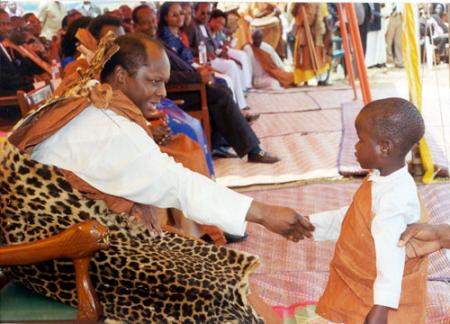
The Bantu are a group of people who speak related languages and have similar social characteristics. They occupy a large part of Zaire and southern as well as eastern Africa. The Bantu are said to have originated from somewhere in the Congo region of central Africa and spread rapidly to the Southern and eastern Africa. (Today, more than one half of the population of Uganda are Bantu.) There are several groups speaking different Bantu Languages.
Bantu are said to have settled in Uganda between A.D. 1000 and A.D. 1300. Some reasons are given to explain why the Bantu moved from their original homeland to come to settle in Uganda. One reason is that they might have been overpopulated and therefore some groups decided to move away in search of vacant lands on which to practice agriculture. Another reason given is that they might have moved away just in search of fertile lands or due to internal conflicts within their communities or external attacks by their neighbors. Other reasons suggested include diseases and natural disasters which might have made them uncomfortable in their homeland and so they decided to move away. One other reason is that they may have been encouraged to move away in quest of adventure and this was because they had invented iron tools which enabled them to confront wild animals and other obstacles during their movements.
Having moved away from their original homeland, the Bantu who settled in present Uganda include; the Baganda, the Banyoro, the Batooro, the Banyankole, the Bakiga, the Bafumbira, the Basoga, the Bagwere, the Banyole, the Bagishu and the Basamia-Bagwe.Though there are striking similarities in language and customs among the different Bantu groups, each group has its own peculiarities in customs and other social arrangements.
EFFECTS OF THE BANTU MIGRATION
The coming of the Bantu to Uganda had many effects. The most obvious among such effects is that they led to the settlement and increased the population of eastern, central, and southern Uganda. They are also credited with introducing iron working in Uganda. Although it is not yet clear whether it was the Bantu or the legendary Bachwezi who introduced iron working in Uganda, We still believe that the Bantu might have come with the idea because their movement coincided with the Iron Age 9A.D 500-500).
It is also stated that the Bantu introduced centralized governments of the type that existed in the Bantu kingdoms of Buganda, Bunyoro-kitara, Nkore and Toro, Igara and Buhweju. The assertion however has raised a number of theories. Some historians assert that the idea of centralized government could have been an indigenous one. They attribute state formation to the Bachwezi whom they say were Hamites from Ethiopia who were of either Portuguese or Greek origin. Such assertions are presently not taken very seriously because they contain a lot of bias against the idea of African initiative. It can therefore be tentatively stated that the Bantu brought the idea of centralized state formation while these assertions are subjected to further research.
The Bantu are also said to have introduced agriculture. This is true because their predecessors were essentially hunters and gatherers. In addition to agriculture, the Bantu also introduced crops such as millet and Sorghum.
The Bantu can be categorised into the following groupings with distinctive cultures

 Posted in
Posted in 

